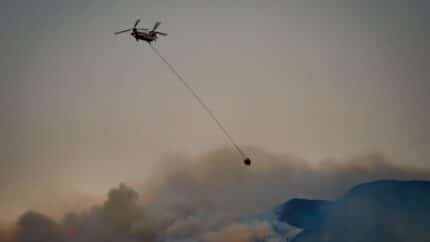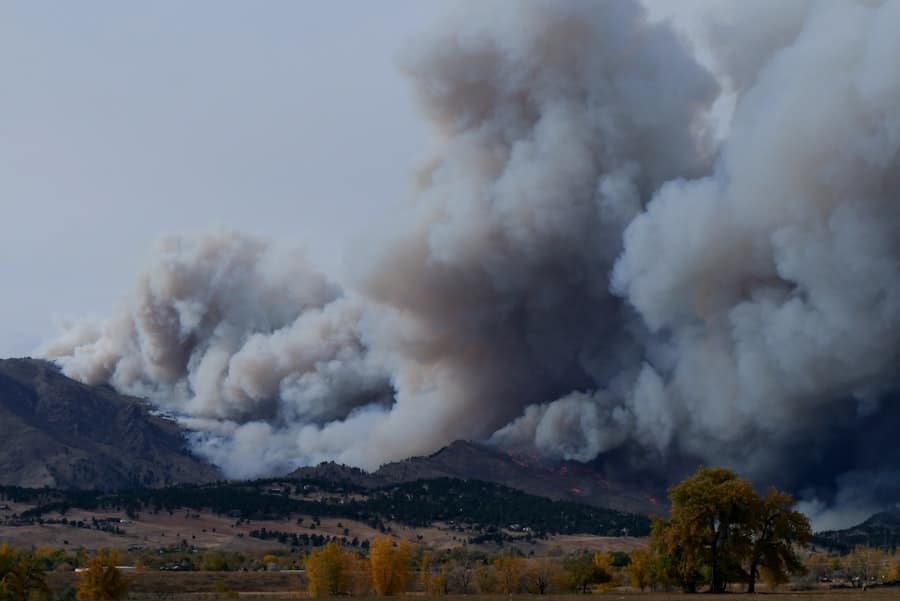Wildfires Ravage Western United States: Climate Change Blamed for Devastating Season

The Western United States is currently facing one of the most devastating wildfire seasons in recent history. From California to Oregon to Washington, wildfires have been raging across the region, destroying homes, displacing residents, and wreaking havoc on the environment. The combination of climate change, drought conditions, and heat waves has created the perfect storm for these wildfires to spread rapidly and intensify. As a result, residents are being forced to evacuate, firefighters are struggling to contain the blazes, and wildlife and natural habitats are being decimated. It is clear that urgent action is needed to address the growing wildfire crisis in the Western United States.
The 2020 Wildfire Season is One of the Worst on Record
The 2020 wildfire season has been one of the most severe on record. According to data from the National Interagency Fire Center, as of September 2020, there have been over 44,000 wildfires in the United States this year, burning more than 7.3 million acres of land. This is a significant increase compared to previous years, with 2019 seeing just over 4.5 million acres burned by wildfires.
In addition to the sheer number of wildfires, the intensity and severity of these fires have also been unprecedented. The August Complex Fire in California, for example, has become the largest wildfire in state history, burning over 1 million acres. The fires have also been responsible for numerous deaths and injuries, as well as the destruction of thousands of homes and structures.
Climate Change is a Major Factor in the Devastating Wildfire Season
Climate change is a major factor contributing to the severity of the current wildfire season. Rising temperatures, prolonged droughts, and changing precipitation patterns all create conditions that are favorable for wildfires to ignite and spread.
Warmer temperatures increase evaporation rates and dry out vegetation, making it more susceptible to catching fire. This, combined with reduced snowpack and earlier snowmelt, leads to drier conditions and a longer fire season. In fact, research has shown that the length of the wildfire season in the Western United States has increased by over 2 months since the 1970s.
Furthermore, climate change is also altering weather patterns, leading to more frequent and intense heat waves and thunderstorms. These extreme weather events can ignite wildfires or exacerbate existing ones. For example, dry lightning strikes during a heat wave can easily spark fires in areas with dry vegetation.
Drought Conditions and Heat Waves Fuel the Flames
Drought conditions and heat waves play a significant role in fueling wildfires. Droughts create dry conditions, reducing soil moisture and drying out vegetation, making it more susceptible to catching fire. The lack of moisture also means that fires can spread more quickly and be more difficult to contain.
Heat waves exacerbate these conditions by increasing evaporation rates and drying out vegetation even further. High temperatures also increase the likelihood of lightning strikes, which can ignite fires in areas with dry vegetation.
The 2020 wildfire season has seen record-breaking heat waves across the Western United States. In August, Death Valley, California recorded a temperature of 130 degrees Fahrenheit, which is one of the highest temperatures ever recorded on Earth. These extreme temperatures not only increase the risk of wildfires but also pose a threat to human health.
Residents Forced to Evacuate as Wildfires Threaten Homes and Communities
The impact of wildfires on residents cannot be overstated. Thousands of people have been forced to evacuate their homes as wildfires threaten their communities. These evacuations are often sudden and chaotic, leaving residents with little time to gather their belongings or make arrangements for their pets and livestock.
The emotional toll on residents is immense. Many have lost their homes and all of their belongings, while others are left wondering if they will have a home to return to. The uncertainty and fear that comes with living in an area at high risk of wildfires can also take a toll on mental health.
The economic impact of wildfires is also significant. The destruction of homes and structures means that residents have to rebuild their lives from scratch. The cost of rebuilding can be astronomical, and many residents may not have adequate insurance coverage to help them recover. Additionally, the loss of tourism revenue in areas affected by wildfires can have a long-lasting impact on local economies.
Firefighters Struggle to Contain the Blazes Amidst Challenging Conditions
Firefighters are on the front lines battling these wildfires, but they are facing unprecedented challenges. The combination of extreme heat, strong winds, and difficult terrain makes it extremely difficult to contain the blazes.
The sheer size and intensity of the fires also make them more difficult to control. The August Complex Fire in California, for example, has been burning for over a month and has grown to over 1 million acres. Firefighters are working around the clock, but the resources and manpower needed to fully contain these fires are often stretched thin.
The physical toll on firefighters is immense. They are exposed to extreme heat, smoke, and ash, putting them at risk of heat exhaustion, respiratory issues, and other health problems. The mental toll is also significant, as firefighters are constantly faced with dangerous and life-threatening situations.
Smoke and Ash from Wildfires Cause Health Concerns for Residents
The smoke and ash from wildfires pose significant health risks for residents in affected areas. Wildfire smoke contains a mixture of gases and fine particles that can irritate the respiratory system and cause a range of health problems.
Exposure to wildfire smoke can exacerbate existing respiratory conditions such as asthma and chronic obstructive pulmonary disease (COPD). It can also cause symptoms such as coughing, wheezing, shortness of breath, and chest pain. In severe cases, it can lead to respiratory distress and hospitalization.
The long-term effects of exposure to wildfire smoke are still being studied, but research suggests that it may increase the risk of developing respiratory conditions and other health problems. Children, the elderly, and individuals with pre-existing health conditions are particularly vulnerable to the health effects of wildfire smoke.
Wildlife and Natural Habitats Suffer as Wildfires Destroy Millions of Acres
The impact of wildfires on wildlife and natural habitats is devastating. Millions of acres of land have been burned, destroying the homes and habitats of countless species. The loss of vegetation also means that animals lose their food sources, leading to starvation and displacement.
The destruction of natural habitats has long-term ecological effects. It disrupts ecosystems and can lead to the loss of biodiversity. Some species may be unable to recover from the loss of their habitat, leading to population declines or even extinction.
Furthermore, the loss of vegetation can also lead to increased soil erosion and water pollution. Without vegetation to hold the soil in place, heavy rains can wash away the topsoil, leading to sedimentation in rivers and streams. This can have a negative impact on water quality and aquatic ecosystems.
Government Agencies and Nonprofits Work Together to Provide Aid and Support
In response to the wildfires, government agencies and nonprofits have been working together to provide aid and support to affected communities. The Federal Emergency Management Agency (FEMA) has been providing financial assistance to individuals and communities affected by the wildfires, including funds for temporary housing, home repairs, and other disaster-related expenses.
Nonprofit organizations such as the American Red Cross have also been providing emergency shelter, food, and supplies to those displaced by the wildfires. They have set up evacuation centers where residents can find temporary shelter, meals, and other necessities.
In addition to immediate relief efforts, government agencies and nonprofits are also working on long-term recovery plans. This includes providing assistance to help residents rebuild their homes and communities, as well as implementing measures to prevent future wildfires.
Long-Term Solutions Needed to Address the Growing Wildfire Crisis in the Western United States
While immediate relief efforts are crucial, it is clear that long-term solutions are needed to address the root causes of the growing wildfire crisis in the Western United States. This includes addressing climate change, implementing policies to reduce greenhouse gas emissions, and investing in renewable energy sources.
Land management practices also play a role in preventing wildfires. This includes thinning forests, removing dead vegetation, and implementing controlled burns to reduce fuel loads. Communities can also take steps to create defensible spaces around homes and structures, such as clearing brush and maintaining a safe distance between buildings and vegetation.
Education and awareness are also key in preventing wildfires. Residents need to be educated about the risks of wildfires and how to protect themselves and their homes. This includes creating evacuation plans, having emergency supplies on hand, and staying informed about fire conditions in their area.
The 2020 wildfire season in the Western United States has been one of the most severe on record. Climate change, drought conditions, and heat waves have created the perfect conditions for wildfires to spread rapidly and intensify. The impact on residents, firefighters, wildlife, and natural habitats is devastating.
Urgent action is needed to address the growing wildfire crisis. This includes addressing climate change, implementing land management practices to reduce fuel loads, and educating residents about wildfire prevention and preparedness. It is crucial that individuals and policymakers come together to find long-term solutions to protect communities and the environment from future wildfires.
While wildfires continue to ravage the western United States, scientists are pointing to climate change as the main culprit behind this devastating season. According to a recent article on CNN News18, the increasing frequency and intensity of wildfires can be attributed to the changing climate patterns caused by global warming. As temperatures rise and drought conditions worsen, the risk of wildfires escalates, posing a significant threat to both human lives and natural ecosystems. To learn more about the impact of climate change on our environment, check out this thought-provoking article: https://thetruthbehind.tv/ufo-spotted-over-junagadh-and-jamnagar-latest-news-updates-cnn-news18/.
Leave A Reply
You must be logged in to post a comment.









 Paranormal
Paranormal

